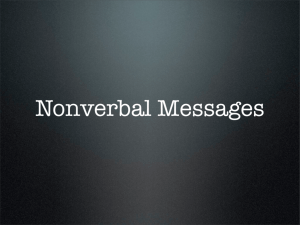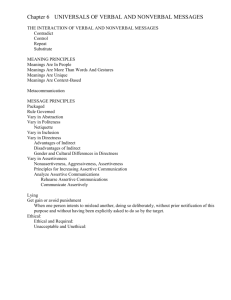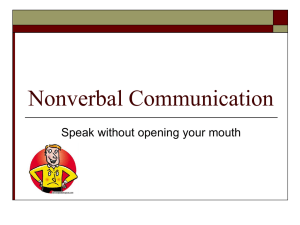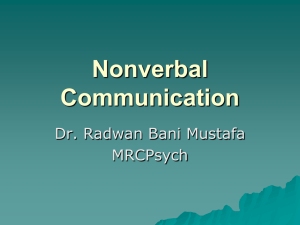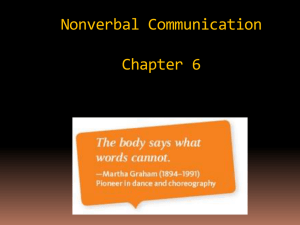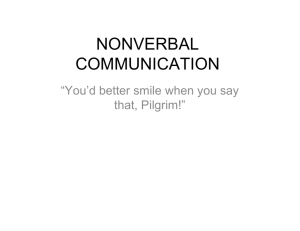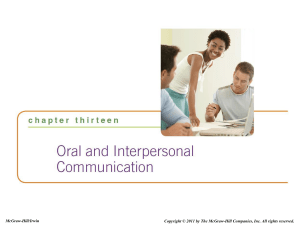nonverbal messages
advertisement
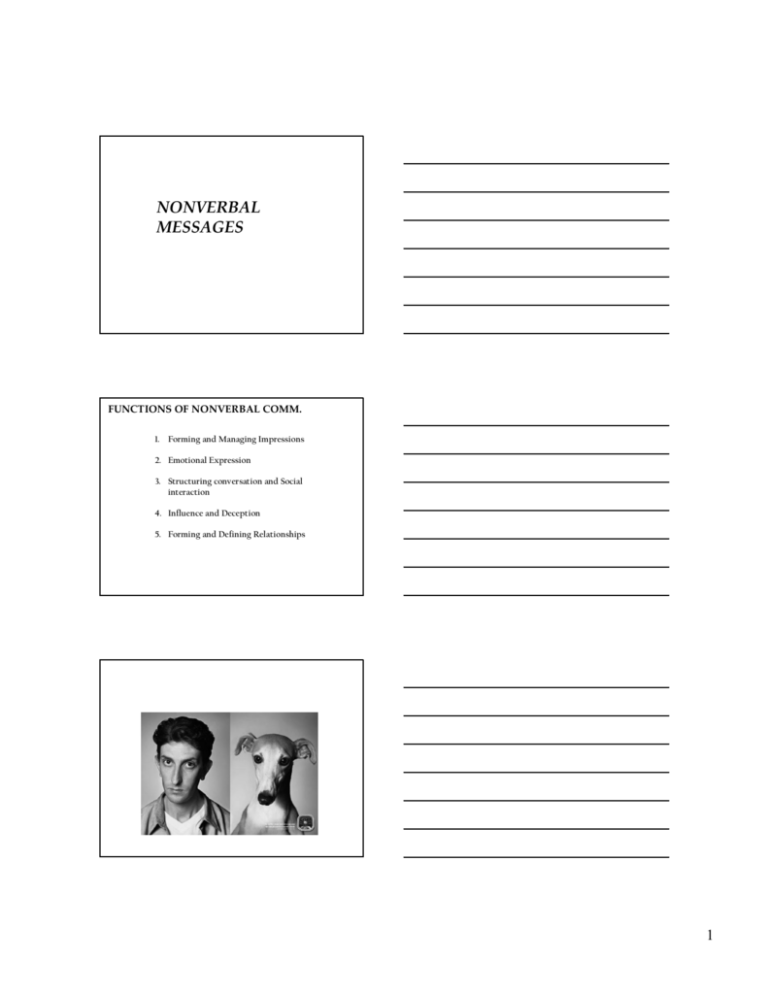
NONVERBAL MESSAGES FUNCTIONS OF NONVERBAL COMM. 1. Forming and Managing Impressions 2. Emotional Expression 3. Structuring conversation and Social interaction 4. Influence and Deception 5. Forming and Defining Relationships 1 2 CHANNEL OF NONVERBAL MESSAGES 1. Body Messages 2. Facial & Eye Movements 3. Spatial & Territorial Communication 4. Artifactual Communication 5. Touch Communication 6. Paralanguage & Silence 7. Time Communication 1. Body Messages:5 types of body movements :- Process where you regulate your own body movement & gestures to comm. desired meanings 1. Emblems – body gestures that directly translate words 2. Illustrators – non verbal behaviors literally illustrate verbal messages 3. Affect displays – communicate emotional meaning (movement of the face) 4. Regulators – behaviors that monitor, control, coordinate the speaking of others 1. Body Messages:5. Adaptors – nonverbal behaviors that are emitted without conscious awareness Self-adaptor – self touching movement Alter adaptors – movement directed at the person with whom you are speaking Object adaptors – gestures focuses on objects 3 1. Body Messages:Body Appearance – general body appearance • Height & weight • Hair length, color and style • General attractiveness 2. Facial & Eye Movement a) Facial Communication communicates the degree of pleasantness, agreement and sympathy felt 4 2. Facial & Eye Movement Facial Management Techniques - Techniques use to hide or emphasize emotions to others 1. Intensifying to exaggerate a feeling 2. Deintensifying to underplay a feeling 3. Neutralizing to hide a feeling 4. Masking to replace the expression of one emotion for another 2. Facial & Eye Movement b) Eye Communication the eye are regarded as the most important nonverbal messages system Functions of eye movement:1. 2. 3. 4. 5. 6. To seek feedback To signal the openness in comm. channel To signal the nature of a relationship To change the psychological distance To help others maintain privacy To signal lack of interest 3. Spatial & Territorial Communication Spatial distances:the way in which you treat (use) a space 1. Intimate – touching to 18 inches 2. Personal – 18 inches to 4 feet 3. Social – 4feet to 12 feet 4. Public – 12 feet to 25 feet 5 3. Spatial & Territorial Communication Territorial :the ownership or possessive reaction to a particular space or object Primary territories Areas that you call your own Secondary territories Areas that’s not your but you have occupied Public territories Areas that are open to public 3. Spatial & Territorial Communication Human use marker to signal their ownership 1. Central markers – reserves a territory 2. Boundary markers – set boundaries between your territory and others 3. Ear markers – identify your possessions Artifactual Comm.:- messages that are human-made 1. Color communication 2. Clothing & Body Adornment 3. Space Decoration 4. Smell Communication 1. Attraction messages 2. Identification messages 6 Color + Clothing + Space Decoration Color + Clothing + Space Decoration Color + Clothing + Space Decoration 7 Touch Communication - the communicative function of touch and touching behavior The Meaning of Touch 1. Positive emotions 2. Playfulness 3. Control 4. Ritual 5. Task-relatedness Paralanguage & Silence Communication Paralanguage – the vocal but nonverbal dimension of speech * It has a lot to do with how you say something. 1. Judgment about people you make judgment about another’s personality on the basis of the person paralinguistic cues 2. Judgment about comm. effectiveness how fast you talk influences how others perceive you Paralanguage & Silence Communication Silence – the absence of sound but not communication Silence may be used to:1. 2. Allow for thinking time Hurt others 3. 4. Respond to personal anxiety, shyness or threats Prevent comm. 5. 6. Communicate emotional responses Say nothing when you have nothing to say 8 Time Communication The use of time, how you organize and react to time Cultural Time 1. Formal time – arbitrary & culturally established ( second, years, semesters) 2. Informal time – general terms ( forever, soon, immediately) Time Communication Monchronism People compartmentalize time Polychronism People schedule several things at a time Time Communication Social Clock The right time according to your culture & society, to do a variety of important things 9 Time Communication Psychological Time - past orientation - Present orientation - Future orientation 10
